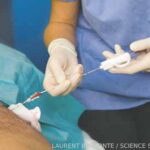TR: It sounds like a liquid biopsy could change the face of lupus nephritis treatment for patients and providers. Is it useful for prognosis?
Dr. Fava: Yes. Remember why we treat lupus nephritis: because we want to save kidneys. In patients with lupus nephritis, there is a 20% risk of end-stage kidney disease [ESKD] in 20 years, and 70% of the patients who get ESKD are younger than 50. The catch is that when we treat lupus nephritis, we must observe patients for five to seven years to know if they’re losing kidney function with our current approach of monitoring proteinuria. No one wants to do a clinical trial that long. And we don’t want to realize a treatment isn’t working after the kidney is already gone.
Proteinuria is not a true response biomarker, and we need one.
There’s a urine biomarker that could be a response biomarker, and our new ACR abstract demonstrated this.4 We followed patients in a urine proteomics study for up to eight years, and 30% of patients permanently lost ≥40% of their glomerular filtration rate (GFR) or got ESKD.
In these patients, there was an elevation of urine biomarker(s) at one year, which is consistent with persistent lupus nephritis inflammation. These patients were more likely to lose kidney function over time. What’s more, even patients classified as complete responders, with a UPCR <0.5, were still much more likely to lose kidney function after four to five years if they had high urine biomarker activity.
The opposite was also true. Among patients classified as non-responders due to persistent proteinuria, those whose biomarkers denoted no activity had a much lower risk of losing kidney function in the future.
In summary, the urine biomarker parallels intra-renal lupus nephritis activity. A decline in urinary biomarker correlates with the most impactful outcome: kidney survival.
TR: Could liquid biopsy one day replace renal biopsy?
Dr. Fava: The most impactful application of the liquid biopsy isn’t at time of diagnosis, and renal biopsy still needs to be pursued in the majority of patients for diagnostic purposes. They are different tests, and each has its own place. For example, a urine assay won’t tell you about the shape of tubuli, and a renal biopsy won’t tell you about molecular activity.
However, the comparison with kidney biopsy is to be demonstrated. We have preliminary data in a study of patients who had repeat renal biopsies [Note: presented at ACR Convergence 2025]. These data suggest we could capture residual inflammation present on biopsy.5



